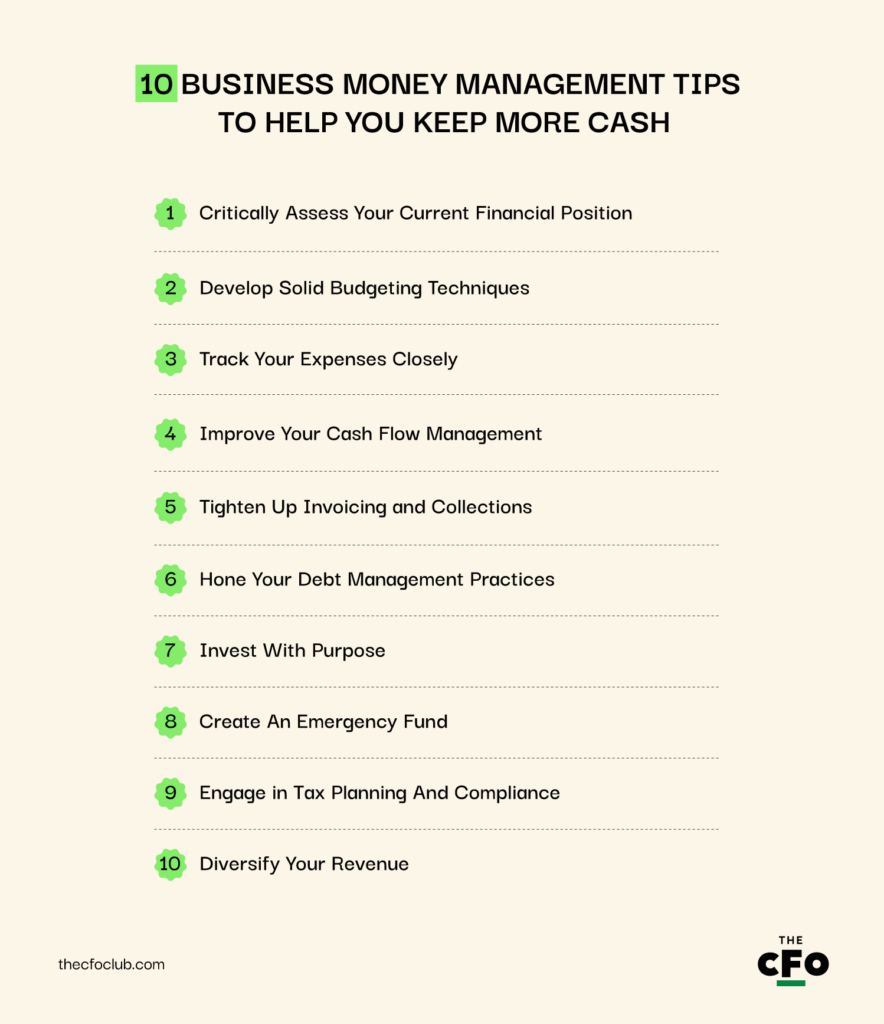If cash flow is a worry, I'd like to start out by giving you the small comfort that you aren’t alone. Business money management is on the mind of pretty much every business owner, leader, and manager out there.
How can I extend my runway? Should that cash be invested? What in?
I get it. After recently finding myself stressed about money (again), I decided to write down the 10 strategies I’ve implemented to help control costs, optimize cash flow, and finally allow me to take a vacation.
What Does Effective Money Management Look Like?
Money management is the practice of setting goals, budgeting, monitoring cash flows, and using your profits wisely. Regardless of your industry, it comes with the territory.
Having a solid grasp on your business finances ensures that you can:
- Anticipate and prepare for unexpected expenses
- Reduce financial stress
- Gain greater control over your cash flow
- Strategically allocate resources
- Confidently make informed decisions
- Pursue new opportunities
- Ensure long-term financial stability
- Create sustainable growth
But there’s a reason more than half of all businesses fail in the first year: it ain’t easy.
Here are ten business money management tips to help you keep more cash.

1. Critically Assess Your Current Financial Position
Before you can implement any of the following money management strategies, you need a clear understanding of your current financial situation. So, start here:
- Gather all relevant financial documents. Include bank statements, invoices, receipts, tax returns, and the following financial statements (known as a 3-statement model): Profit and loss statements, balance sheets, and cash flow statements. Altogether, these items help you identify strengths and weaknesses in your business, systematically.
- Categorize different types of expenses. Break expenses into operational and capital expenses to understand where money is being spent.
- Calculate your net profit. Subtract your total expenses from your total revenue to understand your overall profitability and identify areas for cost reductions or revenue increases.
Get An Accounting Tool to Help
Our team has put together a list of the best accounting software for business operators like you, to help keep cash under control. Here’s what rose to the top:
2. Develop Solid Budgeting Techniques
Hoping to improve your company's cash position without a well-thought-out plan and a realistic budget just isn't going to happen.
It takes as much energy to wish as it does to plan.
Eleanor Roosevelt
Use these budgeting techniques to optimize your cash flow and align your expenses with your revenue.
- Create a comprehensive, detailed budget. It must account for all your expected income and expenses and be reviewed and updated regularly to reflect any changes in your business operations or market conditions.
- Break down your budget into different categories. Break expenses, such as sales, marketing, operational costs, and administration, into buckets to see precisely where your money is being spent.
- Create cash flow projections. These projections should forecast all revenues coming in and money going out over a specific period, such as a month or a quarter, to help you anticipate potential cash flow shortages and plan accordingly.
- Regularly compare your budget to the actual amounts spent. One of the most underused steps, comparison, ensures that your budgets continue to be useful. If your numbers are super far off, do it over; otherwise, it becomes pointless to have.
Having a realistic budget helps your company successfully:
- Identify areas where costs can be reduced.
- Negotiate better terms with suppliers and vendors.
- Increase profitability and a stronger financial position.
- Make more informed investment decisions.
- Determine where and when to allocate funds for growth initiatives.
- Better manage your expenses and have more financial control.
- Maximize the impact of your financial resources and drive long-term success.
Do You Have a Marketing Budget?
You're squandering valuable cash if your marketing dollars have been all over the map with no results — but this is exactly what most people are dealing with. You need a realistic budget to deliver value.
Set a smaller, hyper-targeted marketing activities budget to ensure your marketing spend is making an impact while reducing your costs. How much is realistic? Most small businesses spend between 7% and 10% of gross revenues on advertising.
3. Track Your Expenses Closely
Closely tracking your business expenses is a critical component of effective money management.
You can't really know where you are going until you know where you have been.
Maya Angelou
You have to know where your money has been spent if you want to know what needs to change and why. This requires closely tracking expenses to identify spending patterns and areas for cost savings, eliminate unnecessary expenditures, and ensure that your resources are efficiently allocated.
Here's how you can easily track your expenses:
- Automate this process. Use expense-tracking software to uncover spending patterns.
- Check out your buckets. Those buckets I told you to make in the last tip? Yeah, check them out — keep a close eye on areas in which you’re overspending, and start monitoring spending patterns.
- Conduct regular expense reviews and audits. Each month or quarter, examine your company's spending closely and look for opportunities to optimize, like finding more cost-effective suppliers or cutting back on discretionary expenses. A financial management software can help with this.
Closely monitoring your expenses ensures you can:
- Make more informed business decisions about where to allocate your resources.
- Ensure that your spending aligns with your overall business goals.
- Identify and eliminate unnecessary or excessive spending.
- Identify and adjust for trends or seasonal expenses.
- Predict future cash flow needs more accurately.
Have Seasonal Costs?
By tracking overhead costs and analyzing the results, your company can identify changes in contractor costs that might typically increase at a specific time each year.
Instead of simply feeling broke around a certain season, you can anticipate the change and budget for the increase (or pause on those vendors altogether) over the season.
4. Improve Your Cash Flow Management
Effective cash flow management is essential for your business's long-term success and stability.
Some of the most effective ways to improve cash flow management include understanding cash flow sources, statements, and formulas, then:
- Automating your cash flow system. Leveraging payment automation solutions will streamline the process, reduce the risk of late or missed payments, and increase real-time visibility.
- Accelerating your Accounts Receivable (AR) processes. This includes invoicing and collections processes like sending invoices promptly, offering early payment discounts, and following up on outstanding payments in a timely manner. To do this without bloating your team, consider implementing an AR automation tool.
- Negotiating better terms with your suppliers and vendors. This helps secure longer payment terms, discounts for early payments, or more favorable pricing.
- Invoice factoring. This solution isn't for everyone, and definitely not applicable all of the time. But if you're looking to increase your cash flow for a moment, you can turn to invoice factoring for immediate cash until your invoice is paid by your client.
5. Tighten Up Invoicing and Collections
I've worked in Accounts Receivable (AR) collections for a few years, and trust me, effective invoicing and collections practices are essential to maintaining a healthy cash flow and ensuring the financial stability of your business.
Here's how to successfully tighten AR invoicing and collection processes:
- Streamline your invoicing system. This includes ensuring that all invoices are sent out promptly and accurately.
- Use invoicing software that automates the process. The software should provide detailed tracking and reporting, helping you stay on top of outstanding payments and reduce the likelihood of errors or delays.
- Be more proactive and persistent. Your approach should involve establishing clear payment terms and communicating them clearly to your customers.
6. Hone Your Debt Management Practices
Working in accounting for many years, I learned about the power of debt and compounding interest rates on the bottom line. No matter how much revenue your company brings in, it will always struggle with debts; especially if interest rates are high.
Good debt management requires you to:
- Carefully review your existing debt. Pay attention to interest rates, repayment terms set by lenders, and the overall impact on your cash flow.
- Identify opportunities to consolidate or refinance your debt. Look for more favorable terms that can help you save on interest payments and simplify your repayment schedule.
- Implement a debt repayment plan. Prioritizing high-interest debt and the most important financial obligations may mean making larger monthly payments, negotiating with creditors, or exploring alternative financing options, such as small business loans, business credit cards, or lines of credit.
- Keep your personal finances and debts separate from your business. Suppose you’re a startup or sole proprietor. In that case, it’s important not to mix your personal expenses with that of a business, so you can have a clear picture of what’s necessary to run your operations (and keep from overspending).
7. Invest With Purpose
Business money management isn't just about managing your day-to-day finances. It's also about being purposeful with your investments to meet current cash flow needs, while getting better returns on your money over the long term (without taking unnecessary risks).
Over the years, I’ve found that many small business owners are worried about being able to meet their cash flow needs, so they simply leave all available money in a basic business checking account and minimal ROI. As a business owner, I get it; but this is a missed opportunity.
Here’s the investment strategy I use — stagger your investments to plan for near- and long-term goals:
- Near Term Goals: Identify your goals for next year and invest in redeemable Guaranteed Investment Certificates (GICs) or a similar safe, cashable investment for a one-year period. This type of investment protects your principle while giving you a better return than your checking account.
- Long Term Goals: Talk with your investment banking rep about some investment options that protect your remaining funds for the long-term. I typically stagger funds in two, three, and five year redeemable investments, like GICs, that offer higher returns while safeguarding your original investments. It’s important to be able to cash them in if the need suddenly arises, while still making more than they would, just sitting in an account.
I always do my own research on what my bank rep recommends, to ensure I don’t invest in anything that I don’t understand (or that doesn’t inspire confidence of a return). Monitor your investments quarterly (at least), making sure they’re doing what you’d expect, and don’t be afraid to make changes if circumstances necessitate it.
8. Create An Emergency Fund
Building and maintaining an emergency fund provides your business with a cash reserve and safety net in the event of unexpected expenses, economic downturns, or other financial challenges.
Save and set aside a minimum of three to six months' worth of company profits to ensure that you have the necessary resources to cover essential costs, such as payroll, rent, and utilities in the event that your revenue dips.
Disaster Preparedness and Business Continuity
No business is immune to disasters — especially if you’re small. Over 40% of small businesses close permanently after a disaster. You read that right: 40%. If that wasn’t grim enough, among the 60% that survive the immediate term, 25% fail within a year.
A well-funded emergency reserve can give you peace of mind and financial flexibility to navigate unforeseen events like these, enabling you to make strategic decisions without the added stress of cash flow concerns.
9. Engage in Tax Planning And Compliance
Effective tax planning and compliance sound boring, but they really help. If you want to end up with more spare cash:
- Get to know industry-specific tax laws and implications. Stay up to date with changes through your local or federal business tax authorities to ensure you’re not missing out on tax breaks for your business.
- Contact business tax specialists. Find tax accountants or tax lawyers who can help guide you in the right direction. Getting a lay of the land as it relates to your industry-specific taxes can be well worth the money.
- Use business tax software. Automate calculations for tax obligations and ensure timely reporting, saving time, penalties, and frustration.
10. Diversify Your Revenue
Now that you've addressed ways to keep more cash, you should also look for ways to increase revenue and profits. Start here:
- Look at your competitors to identify opportunities. Their offerings can tell you how well customers receive their new products or services, and if it's worthwhile.
- Analyze your existing offerings. Determine if your customers’ needs are still being met or if your offerings need to be changed. I suggest talking with customers about what they like and don't like. Use surveys, customer support logs, or direct feedback to get more insight.
- Conduct a SWOT (strengths, weaknesses, opportunities, and threats) analysis. This will help you identify other potential revenue sources. While less certain than imitating competitors’ products, at least it’s original!
Increasing or diversifying your company's revenue through new target markets and more innovative products and services helps you attract or retain a larger customer pool. It also reduces your reliance on a single customer or market segment and mitigates the risk of revenue fluctuations.
The Final Strategy
Use software, and keep expert voices close by. I wish I were kidding, but it really can be that simple.
Figure out:
- What kind of accounting software is best for your business, and
- The basics of using it well.
Then, of course, subscribe to our free newsletter for expert advice, guides, and insights from finance leaders shaping the tech industry.



